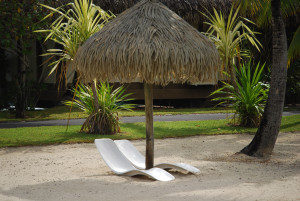French Polynesia, or more specifically Mo’orea, the island 12 miles west of Tahiti, is home to the capital city of Papeet. Alisa and I arrived late one night via a very lovely and not too long flight on Air Tahiti Nui. Papeet is not only the capital but also the international hub for all air travel. Once in Papeet, flights and ferries are plentiful to the various surrounding islands including Bora Bora, Motu One and Mo’orea.
We chose to catch a short flight to Mo’orea, which literally translates to mean “yellow lizard,” based on the legend that the two prominent bays of this heart-shaped island were opened up by the tail of a giant lizard. Even if you have never been to the region, you will immediately recognize French Polynesia from the iconic and traditional thatched-roof bungalows perched over lagoon waters called motus. If you are lucky enough to make it to this island paradise, treat yourself to a stay in one of these bungalows. Each stands independent over the water and has a small dock with ladder access into the crystal clear water. At night, lighting underneath these docks attracts a diverse and beautiful array of fish, eels, rays and more.
So back to the greeting, “My Roux, Roux.” It turns out that she is actually saying “maruru” or “thank you.” This is a very common saying with the Tahitians, as they do seem genuinely appreciative of all visitors. But in Mo’orea, this gratitude is even more profound. With barely 12,000 inhabitants, you feel as though you have the island to yourself. If you are ever looking for a place to truly unplug, I can think of no better place to turn off the cell phone, ditch the laptop and leave your Facebook status un-updated. It will keep.
The favorite pastime is to truly relax on the beach and do a whole lot of nothing. Should you decide to leave the sandy beach, the island is very easy to navigate. In fact, when we asked for a map of the island, the rental car agent drew a big circle and basically said to keep driving until we arrived back at our hotel! While circling the island, be sure to stop at a marae or ancient temple constructed of stone and coral. Primarily used for religious ceremonies dating back to 900 A.D., most of these marae no longer resemble their former glory as they were destroyed as Christian explorers arrived on the island. Now, all that physically remains are the floors and outlines of the buildings, but the energy and history is abundant and profound. (Continues in G Style, page 31)
Exploring this small island takes little or no time, so do make sure to enjoy the wetter side of the island activities. We opted for a guided Jet Ski tour, which took us beyond the break of the waves into the deep, vast ocean waters. We were greeted by schools of dolphins, which rode along with us and massive stingrays with wingspans in excess of six feet who gently glided beneath us.
Located in the same time zone as Hawaii but with a fraction of the visitors, French Polynesia has long been known as the “honeymooners destination.” With crystal blue waters and sugar sand beaches, it is clear why couples would choose to vacation here, but it is certainly not the only reason to visit. If fact, we observed much that reminded us of our diverse Austin community, making this island paradise feel a little more like home. Rather than loops around Lady Bird Lake on crushed granite trails, the locals take to circling the island on updated outriggers honoring the transportation of their ancestors.
First, there is an abundance of tattoos, primarily on the men, but some on the younger women, as well. The word “tattoo” is said to be a derivation of the Tahitian word “tatu” which literally translates into “hitting repeatedly”. This Tahitians still practice the traditional form of tattooing that consists of a sharp object dipped into indelible ink and repeatedly “tapped” into the skin. As there is no writing in the Polynesian culture, they have typically used the designs to express their personality and more importantly, their identity.
Expression of identity does not stop at the skin, however. Going back to pre-colonial days, they believed that to posses both masculine and feminine qualities to be a gift from the divine. Only mere mortals are simply male or female but the very special are the “mahu” or “rae raes” who are not limited by one gender, but rather are gender limitless. Traditionally used to describe a man living as a woman, there are conflicting stories about why rae raes are so prevalent in the region. Some legends state that in a family full of sons, one son would adapt to a more feminine gender in order to help his mother (and family) with the more traditionally feminine roles. Others believe that it is not a choice but divine inspiration. Either way, one thing is very clear, these rae raes are fully embraced by their culture. The proof? Discrimination and homophobia are rare on these islands.
Story by Lynn Yeldell
Photos by Lynn Yeldell
L Style G Style – Storyteller of the Austin LBGT Community.
#GetToKnowUs

































